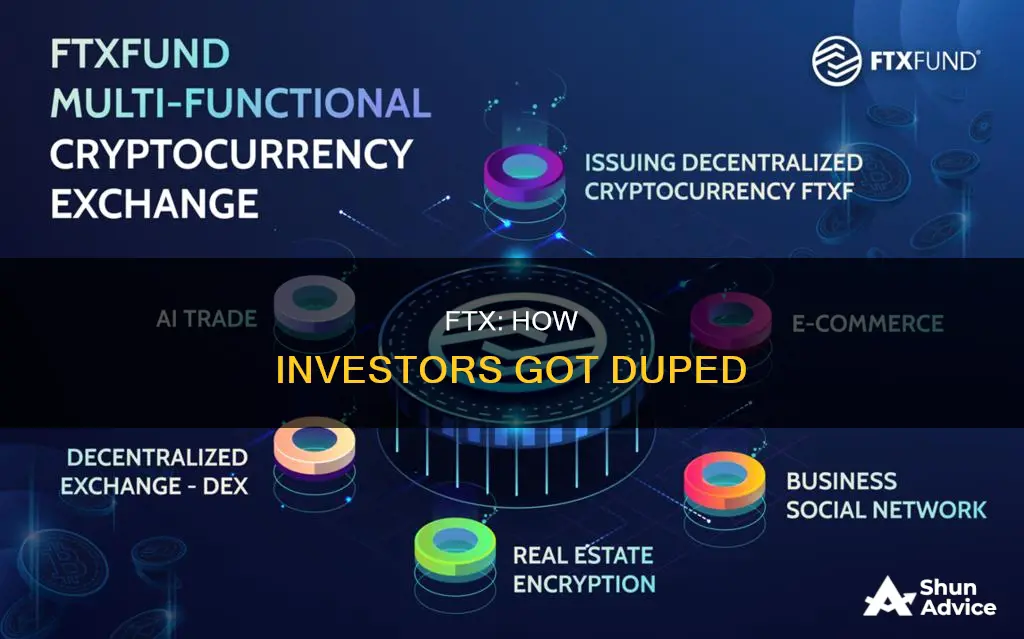
FTX was a cryptocurrency exchange that allowed customers to trade and buy cryptocurrencies. FTX's customers could also store cryptocurrencies on their own by creating a crypto wallet either using software or hardware, which was not part of the platform. FTX was founded by Sam Bankman-Fried in 2019 and was headquartered in the Bahamas. The company's stock was never available for public trading, but it issued a token (FTT) that traded in cryptocurrency markets. FTX's collapse in November 2022 was due to mismanagement of funds, a lack of liquidity, and a large volume of withdrawals.
| Characteristics | Values |
|---|---|
| Company Type | Cryptocurrency exchange |
| Founders | Sam Bankman-Fried, a Massachusetts Institute of Technology (MIT) graduate and former Jane Street Capital international exchange-traded funds (ETFs) trader |
| Founding Year | 2018 |
| Headquarters | The Bahamas (after moving from Hong Kong in September 2021) |
| Regulation | Regulated by the Securities Commission of the Bahamas (SCB) |
| Services | Spot markets, derivatives, options, volatility, and leveraged products |
| Target Audience | Low-income and underbanked individuals, including many young investors in their 20s and 30s |
| Marketing Strategies | High-profile acquisitions, celebrity endorsements, Super Bowl ads, and naming rights |
| Token | FTX issued a token (FTT) that could be used for transaction fees and as margin collateral |
| Investor Profile | Venture capital firms and investment funds |
| Collapse | November 2022 |
| Reason for Collapse | Mismanagement of funds, lack of liquidity, and large volume of withdrawals |
What You'll Learn
- People invested in FTX by buying the FTX token (FTT)
- FTT could be used to pay for transaction fees and as margin collateral
- FTT was traded on cryptocurrency markets similar to a stock
- FTX was incorporated in Antigua and Barbuda and headquartered in The Bahamas
- FTX US was a separate U.S. affiliate where only U.S. residents could trade

People invested in FTX by buying the FTX token (FTT)
FTX created its own digital token, FTT, in May 2019. As more people invested in and demanded the digital token, its value increased. FTX offered perks for staking FTT, such as discounts and NFT rewards. The company also offered other incentives for investing in FTT, such as the opportunity to earn higher yields than the average bank and the ability to use FTT to pay for transaction fees and as margin collateral.
FTX's aggressive marketing campaigns, including celebrity endorsements and high-profile acquisitions, contributed to its rapid rise in popularity. FTX also ran Super Bowl ads and acquired the naming rights to the Miami Heat's arena, further promoting its platform. These campaigns positioned FTX as a safe and trusted investment option, luring in customers with the promise of high yields and secure digital wallets.
Many low-income people invested in FTX, as the exchange allegedly targeted underbanked individuals and convinced them that it was just as safe as a regular bank. FTX even falsely claimed to be insured by the Federal Deposit Insurance Corporation (FDIC), providing a sense of security for potential investors. The company's efforts to target economically vulnerable individuals, particularly millennials, through influencer partnerships and sponsorships, resulted in many people depositing their savings into the trading platform.
The value of FTT dropped significantly when concerns about the financial stability of FTX surfaced. As a result, FTX customers rushed to withdraw their money, leading to further financial troubles for the company. Ultimately, FTX's collapse erased billions of dollars in value from the crypto market and left many investors with significant losses.
February: A Month for Investing?
You may want to see also

FTT could be used to pay for transaction fees and as margin collateral
FTX Token (FTT) is the native cryptocurrency token of the FTX ecosystem. FTT could be used to pay for transaction fees and as margin collateral.
FTT tokens can be staked on the FTX platform to gain rewards based on a variety of factors, such as referral rates, maker fee rebates, and bonus votes, among other things. Staking FTT tokens offers several benefits, including larger referral earnings, free withdrawals of ERC20 and ETH daily, discounts on FTT fees, and maker fee rebates.
FTT tokens can also be used to pay for trading fees on the FTX platform, with traders who are active on the exchange seeing percentage differences of up to 60%. Additionally, FTT tokens can be used as collateral for futures positions, providing insurance protection and ensuring a net profit in moments of market volatility.
FTT tokens were also used in the creation of leveraged tokens on the FTX Exchange, with traders able to buy leveraged tokens to enter into short or leveraged positions without trading on margin. These tokens are ERC-20 compatible and can be listed on any spot exchange.
Investments: Where People Put Their Money
You may want to see also

FTT was traded on cryptocurrency markets similar to a stock
FTX was a centralized cryptocurrency exchange that supported trading for popular cryptocurrencies, non-fungible tokens (NFTs), and spot, derivatives, and leveraged markets. FTX stock was never available for public trading. However, the exchange issued a token, FTT, that was traded on cryptocurrency markets similar to a stock. This token could be used to pay for transaction fees and as margin collateral. According to the cryptocurrency aggregator site CoinMarketCap, the token "no longer has any use and may be liquidated by the estate to pay creditors."
FTT is the native cryptocurrency token of the FTX crypto derivatives trading platform. It was launched on May 8, 2019, and is an ERC-20 standard token. Initially, FTT was established as a reward for exchange transactions, but over the years, its utility has expanded. FTT can now be used in the creation of leveraged tokens on the FTX Exchange, to receive VIP discounts, and to earn rewards for providing liquidity through futures positions.
FTT tokens are also used to reduce trading fees and to secure futures positions. Additionally, profits from massive market movements are distributed among FTT holders. Institutions and investors can pay expenses in FTT tokens when purchasing a white-label version of FTX's OTC portal and futures market. Furthermore, projects can pay listing fees with FTT when creating leveraged tokens. Users can also stake FTT to benefit from discounts, bonus votes, and blockchain fee waivers.
FTT offers commission discounts, allowing members to pay a low fee and obtain tighter spreads. Traders can use FTT as collateral, and those who are active on the FTX Exchange can see percentage differences of up to 60%. FTT staking also provides perks such as discounts, the opportunity to win NFTs, participation in airdrops, bonus votes, and IEO tickets.
Investments: The Drive to Gain More
You may want to see also

FTX was incorporated in Antigua and Barbuda and headquartered in The Bahamas
The Bahamas-based platform was one of two arms of FTX, the other being FTX US, a separate U.S. affiliate where only U.S. residents could trade. FTX US was a money services business (MSB) registered with FinCEN. It was licensed as a Derivatives Clearing Organization, Swap Execution Facility, and Designated Contract Market by the U.S. Commodity Futures Trading Commission (CFTC).
FTX's move to The Bahamas came at a time when the company was growing rapidly. The popularity of the cryptocurrency exchange platform rose quickly after its launch in 2019. By January 2022, the company was worth $32 billion. FTX's growth was driven by its aggressive marketing campaigns, such as Super Bowl ads, celebrity endorsements, and naming rights to sports arenas. These campaigns positioned FTX as a safe and trusted platform for investing in cryptocurrencies, promising higher yields than traditional banks.
However, despite its headquarters in The Bahamas, FTX had a global reach, serving international customers and facilitating deposits and withdrawals in multiple fiat currencies, including the U.S. dollar, euro, British pound, Australian dollar, and Canadian dollar. The company's international presence and aggressive marketing attracted investors from around the world, who were drawn to the platform's ease of use, low fees, and the potential for high returns.
Investing in Others: A Worthy Bet
You may want to see also

FTX US was a separate U.S. affiliate where only U.S. residents could trade
FTX US was a separate affiliate of FTX, where only US residents could trade. FTX US was a money services business (MSB) registered with FinCEN. In October 2021, FTX US completed its acquisition of the cryptocurrency derivatives exchange platform LedgerX, rebranding it as FTX US Derivatives. FTX US Derivatives was licensed as a Derivatives Clearing Organization, Swap Execution Facility, and Designated Contract Market by the US Commodity Futures Trading Commission (CFTC).
While FTX and FTX US had independent capital structures, they shared overlapping management, sources of capital, and marketing. Both companies had the same investors, celebrity endorsements, name-brand sponsorships, and listed Sam Bankman-Fried as CEO and co-founder Gary Wang as CTO. Every investor in FTX's Series C venture capital funding round simultaneously backed FTX US's Series A funding round.
FTX US offered dozens of cryptocurrency spot trading pairs with fiat currencies, along with a marketplace for non-fungible tokens (NFTs). While FTX served international customers, FTX US only supported the US dollar.
Mutual of America: Worth the Investment?
You may want to see also
Frequently asked questions
People could invest in FTX by buying the FTX token (FTT) issued by the exchange. This token could be used to pay for transaction fees and as margin collateral, and it was traded on cryptocurrency markets similar to a stock.
The FTX token (FTT) was a digital token created by FTX in May 2019 to attract new customers. As more people invested in and demanded the token, its value increased.
FTX offered perks for staking FTT, such as discounts and NFT rewards.
FTX did everything in its power to convince low-income adults to use its platform instead of a bank. The company allegedly lied about being insured by the Federal Deposit Insurance Corporation (FDIC), an independent branch of the government that guarantees money in US bank accounts. FTX also offered low fees, free crypto with every trade, and up to an 8% yield on money stored on the platform.







